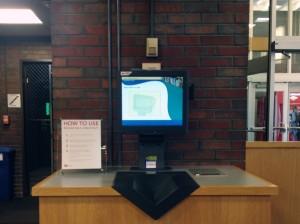
With the start of another academic year, Mugar Memorial Library at Boston University is offering a self-checkout system that serves as a tech-savvy alternative to checking books out at the circulation desk.
“The system is pretty straightforward,” said Associate University Librarian for Undergraduate and Distance Learning Thomas Casserly. “Circulating books that are in the library have a barcode on them. The system reads the bar code and records the transaction after the student swipes their university ID card.”
Casserly said Mugar primarily implemented the self-checkout system, finalized in summer 2014, to make checking materials out of the library more convenient for BU students.
The new checkout machines have seen a relatively small amount of use, he said, and the technology behind Mugar’s self-service system still has some minor issues.
“The communication between the terminal and the library system isn’t perfect,” he said. “We are in what I call a soft launch phase.”
Mary McGowan, head of the Mugar Greene Scholars, said students might encounter a few difficulties when they first use the new self-checkout system.
“I could see people not knowing the barcode or where to find it,” she said. “It’s just a temporary problem. They’re going to figure it out pretty quickly, but that’s just the kind of thing that people have to get used to.”
School of Education junior Sandra Soto said she has not used Mugar’s self-checkout machines yet and is unsure about how many students will utilize the new service.
“I’m kind of curious about how many students actually check out books from the library in the first place and how much of the library is just used for workspace and study space,” she said. “I don’t know what the cost of the new machines is versus their potential benefits.”
Soto also expressed concern about the need to continue to hire students who work at the circulation desk now that a self-service checkout station exists.
“I was just wondering about work-study students who work here,” she said. “Would those machines eventually replace their jobs? Would these machines decrease employment?”
Tingwa Tam, a freshman in Sargent College of Health and Rehabilitation Sciences who works at the circulation desk, said he has spoken with students who have had trouble operating the new machines.
“This one girl came up to me today because her card wasn’t working at the self-checkout,” she said. “So I helped her to check out the books regularly.”
Caitlin Donnelly, a senior in SED, said the self-checkout machines will serve as a convenience not only to students, but also to library staff.
“I can see how the machines would be useful for the librarians if they have tons of other things to do,” she said. “Checking out is a quick thing that would be nice if it could be done independently.”
McGowan said the self-checkout system provides students with more options, but it will never eliminate the need for a circulation desk.
“It’s like all of the technology that we lay out for students to use in order to help them to use the library,” she said. “It will give people another option.”




